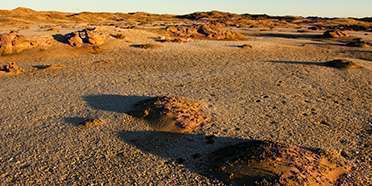- You are here:
- Home
- Countries & Parks
- Namibia Parks
- Tsau //Khaeb National Park
- Reviews
- Expert Reviews
Expert Reviews – Tsau //Khaeb (Sperrgebiet) NP

Emma is an award-winning travel writer for Rough Guides, National Geographic Traveller, Travel Africa magazine and The Independent.
Ghost towns and windswept sandscapes
Its name (which means ‘forbidden place’ in German) may be offputting, but anyone attracted to austere desert landscapes will be intrigued by this remote stretch of southwest Namibia. For most of the 20th century, this region was cordoned off for diamond mining, with severe penalties in place for anyone who approached within 100km. In 2008, Tsau //Khaeb was declared a national park in order to rehabilitate and preserve its sands and inselbergs, and protect its delicate flora, which are nourished by the early-morning sea mists. Parts of the park were opened to members of the public booking guided tours, but visitor numbers remain low.
For me, Tsau //Khaeb’s main attractions are its sense of space and solitude. Stark, lichen-mottled rocks, striking aloes and euphorbias and windswept, sand-engulfed abandoned buildings lend texture and drama. Botanists come here to study the region’s many rarities. Animal sightings are infrequent, even though there are antelopes and hyenas in the park; there are also numerous bird species, particularly on the reed beds and mudflats near the mouth of the Orange River in the far southwest.

Philip is an acclaimed travel writer and author of many guidebooks, including the Bradt guides to Uganda, Tanzania, Kenya and South Africa.
Namibia’s Forbidden territory
This vast national park is the newest in Namibia, proclaimed in 2008, and as such it remains largely undeveloped for tourism. Its German name translates as Forbidden Territory, in reference to the long period when unauthorised entry was forbidden by De Beers, the mining conglomerate that owns it, due to its wealth of diamond reserves. At the moment, the only part of the park accessible without a special permit is the tarred B4 connecting the town of Keetmanshoop to the pretty Germanic port of Lüderitz. The scenery here is truly wild, almost blindingly white in some areas, and although we were unlucky, many visitors encounter the region’s famed herd of feral horses en route. Also readily accessible by foot or car is the stretch of the Lüderitz Peninsula leading 20km south of town to Diaz Point, where we saw Cape fur seals basking on the rocks, and a variety of marine birds including the rare black oystercatcher, as well as ruddy turnstone, whimbrel, and various gulls and terns.

Lizzie is a reputed guidebook writer and author of the Footprint guides to South Africa, Namibia, Kenya, Tanzania, Uganda and Zimbabwe.
An empty sea of sand, diamond mining ghost towns and intrepid drives
Covering about 3% of Namibia, the Sperrgebiet was for over 100 years out of bounds due to diamond extraction from this part of the Namib Desert. Now under the protection of the Tsau //Khaeb National Park – Nama for ‘deep sandy soils’ – access is still limited, but it can be explored from Lüderitz on guided 4x4 excursions to sites including Bogenfels Rock Arch and the stark but spectacular dunes around Saddle Hill. While the barren landscape seemingly defies life, it does in fact support desert succulents, which survive on the life-giving fog that rolls off the ocean, and lucky visitors may spot gemsbok, springbok or brown hyena. The most accessible part of the park is the eerie mining ghost town of Kolmanskop outside Lüderitz. It is here that the 1908 discovery of diamonds led to German colonialists declaring the Sperrgebiet off-limits so they could collect this glittering wealth from the sand. I find Kolmanskop’s history simply fascinating, and it’s well-documented in the museum and restored buildings like the Recreation Hall or Manager’s House. But my highlight is scrambling through the decaying buildings to try and imagine what it was like for those privileged settlers who incredulously made their life in these unforgiving dunes.

Anthony is a photographer and writer for travel magazines and Lonely Planet, including the guides to Kenya and Botswana & Namibia.
2 people found this review helpful.
Tsau //Khaeb: Forbidden Frontiers
This vast tract of sand-dune wilderness in Namibia’s south (formerly Sperrgebiet NP) is one of Southern Africa’s great unknowns. Closed for decades and under the control of secretive diamond-mining interests, the region is now a park, although a permit is still required. There are some real hard-core adventures to be had here – the multi-day crossing from Lüderitz to Walvis Bay is one of Southern Africa’s most rewarding wilderness adventures, and you’ll need to go with an organised tour to undertake it. But the ghostly, sand-drowned town of Kolmanskop can be visited on a day trip from Lüderitz, while the desert-adapted wild horses that inhabit the arid country west of the town of Aus are another Tsau //Khaeb specialty. Otherwise, wildlife is pretty thin on the ground with brown hyenas, some unusual reptiles (such as the desert rain frog) and rare bird species among the rather elusive highlights.
Average Expert Rating
- 3.0/5
- Wildlife
- Scenery
- Bush Vibe
- Birding
Rating Breakdown
- 5 star 0
- 4 star 0
- 3 star 4
- 2 star 0
- 1 star 0


 Namibia Parks
Namibia Parks